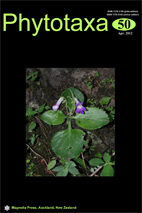Abstract
Fourteen new Myrtaceae are described, illustrated and compared to related species from Brazil: Calyptranthes boanova, C. curta, C. detecta, C. maritima, Eugenia culta, E. rotula, E. serraegrandis, E. unana, Myrcia clavata, M. lascada, M. teimosa, M. truncata, Myrcianthes riparia and Myrciaria alagoana. Calyptranthes boanova is related to C. grandiflora, but presents sessile, glabrous leaves; C. curta is related to C. dichotoma, differing through the small inflorescences; C. detecta is close to C. tricona, but has largest leaves and inflorescences; C. maritima is related to C. strigipes, but presents larger leaves and inflorescences and smaller flowers; Eugenia culta is related to E. sprengelii, but presents verticillate leaves and longer pedicels; E. rotula is distinct from all Brazilian species by its small rounded leaves; E. serraegrandis is related to E. platyphylla, differing in its larger leaves and densely pilose flowers; E. unana is close to E. stictopetala, but the leaves are wider and more laxly venose and the flowers present larger calyx lobes; Myrcia clavata is close to M. riodocensis, but has wider leaves and pentamerous flowers; M. lascada is related to M. palustris, from which it differs by the larger leaves and three to five–flowered inflorescences; M. teimosa is related to M. eximia, differing through shorter inflorescences and four–celled ovaries; M. truncata is distinguished from all Brazilian species through its basally truncate leaves; Myrcianthes riparia is close to M. pedersenii, but has glabrous leaves and flowers, tetramerous flowers and smaller, purple fruits, and Myrciaria alagoana is related to M. glomerata, but has larger petioles and glabrous and caudate leaves. Calyptranthes boanova, Eugenia serraegrandis, E. unana, Myrcia lascada, M. teimosa and M. truncata were collected in the southern Bahian rainforests; Calyptranthes curta and C. maritima are from the coastal rainforests of the southeastern state of São Paulo; C. detecta is from the rainforests of southeastern Minas Gerais; Eugenia culta was collected along the Atlantic Rainforest (Mata Atlântica) domain in the southeastern Brazilian states of Espírito Santo and Minas Gerais; Eugenia rotula was collected in rocky fields from the Bahian hinterland; Myrcia clavata and Myrciaria alagoana are from the Atlantic Rainforest of the northeastern state of Alagoas, and Myrcianthes riparia grows in riverine habitats in the highlands of the southern Brazilian states of Rio Grande do Sul and Santa Catarina. Additionally, there are proposed the rehabilitation of the name Eugenia astringens and the new name Myrcia neopauciflora, based on Aulomyrcia pauciflora.

